Greenhouse gas
From Wikipedia, the free encyclopedia
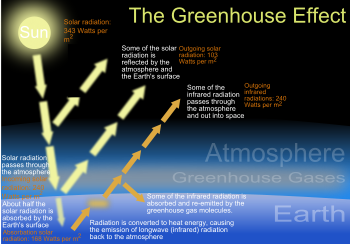
Simple diagram of greenhouse effect.
A
greenhouse gas (sometimes abbreviated
GHG) is a gas in an atmosphere that
absorbs and
emits radiation within the
thermal infrared range. This process is the fundamental cause of the
greenhouse effect.
[1] The primary greenhouse gases in the
Earth's atmosphere are
water vapour,
carbon dioxide,
methane,
nitrous oxide, and
ozone. In the
Solar System, the atmospheres of
Venus,
Mars, and
Titan also contain gases that cause greenhouse effects. Greenhouse gases greatly affect the temperature of the
Earth; without them, Earth's surface would be on average about 33 °C (59 °F)
[note 1] colder than at present.
[2][3][4]
However, since the beginning of the
Industrial Revolution, the burning of
fossil fuels
has contributed to the increase in carbon dioxide in the atmosphere
from 280 ppm to 390 ppm, despite the uptake of a large portion of the
emissions through various natural "sinks" involved in the
carbon cycle.
[5][6] Anthropogenic carbon dioxide (CO
2 ) emissions (i.e., emissions produced by human activities) come from
combustion of
carbonaceous fuels, principally
wood,
coal,
oil, and
natural gas.
[7]
Gases in Earth's atmosphere
Greenhouse gases
Greenhouse gases are those that can absorb and emit
infrared radiation.
[1] In order, the most abundant greenhouse gases in Earth's atmosphere are:
Atmospheric concentrations of greenhouse gases are determined by the
balance between sources (emissions of the gas from human activities and
natural systems) and sinks (the removal of the gas from the atmosphere
by conversion to a different chemical compound).
[8] The proportion of an emission remaining in the atmosphere after a specified time is the "
Airborne fraction"
(AF). More precisely, the annual AF is the ratio of the atmospheric
increase in a given year to that year’s total emissions. For
CO2 the AF over the last 50 years (1956–2006) has been increasing at 0.25 ± 0.21%/year.
[9]
Non-greenhouse gases
Although contributing to many other physical and chemical reactions, the major atmospheric constituents,
nitrogen (N
2),
oxygen (O
2), and
argon (Ar), are not greenhouse gases. This is because
molecules containing two atoms of the same element such as N
2 and O
2 and
monatomic molecules such as Argon (Ar) have no net change in their
dipole moment when they vibrate and hence are almost totally unaffected by
infrared light. Although molecules containing two atoms of different elements such as
carbon monoxide (CO) or
hydrogen chloride
(HCl) absorb IR, these molecules are short-lived in the atmosphere
owing to their reactivity and solubility. Because they do not contribute
significantly to the greenhouse effect, they are usually omitted when
discussing greenhouse gases.
Non-greenhouse gases that have an indirect radiative effect
Carbon monoxide has an
indirect radiative effect by elevating concentrations of
methane and
tropospheric ozone through scavenging of atmospheric constituents (e.g., the
hydroxyl radical,
OH)
that would otherwise destroy them. Carbon monoxide is created when
carbon-containing fuels are burned incompletely. Through natural
processes in the atmosphere, it is eventually oxidized to
carbon dioxide. Carbon monoxide has an
atmospheric lifetime of only a few months
[10] and as a consequence is spatially more variable than longer-lived gases.
Contribution of clouds to Earth's greenhouse effect
The major non-gas contributor to the Earth's greenhouse effect,
clouds,
also absorb and emit infrared radiation and thus have an effect on
radiative properties of the greenhouse gases. Clouds are water droplets
or
ice crystals suspended in the atmosphere.
[11][12]
Impact of a given gas on the overall greenhouse effect
The contribution of each gas to the greenhouse effect is affected by
the characteristics of that gas, its abundance, and any indirect effects
it may cause. For example, on a molecule-for-molecule basis the direct
radiative effects of methane is about 72 times stronger than carbon
dioxide over a 20 year time frame
[13]
but it is present in much smaller concentrations so that its total
direct radiative effect is smaller, and it has a shorter atmospheric
lifetime. On the other hand, in addition to its direct radiative impact
methane has a large indirect radiative effect because it contributes to
ozone formation. Shindell
et al. (2005)
[14] argue that the contribution to climate change from methane is at least double previous estimates as a result of this effect.
[15]
When these gases are ranked by their direct contribution to the greenhouse effect, the most important are:
[11]
Gas
|
Formula
|
Contribution
(%) |
| Water vapor |
H2O |
36 – 72 % |
| Carbon dioxide |
CO2 |
9 – 26 % |
| Methane |
CH4 |
4 – 9 % |
| Ozone |
O3 |
3 – 7 % |
In addition to the main greenhouse gases listed above, other greenhouse gases include
sulfur hexafluoride,
hydrofluorocarbons and
perfluorocarbons (see
IPCC list of greenhouse gases). Some greenhouse gases are not often listed. For example,
nitrogen trifluoride has a high
global warming potential (GWP) but is only present in very small quantities.
[16]
Proportion of direct effects at a given moment
It is not possible to state that a certain gas causes an exact
percentage of the greenhouse effect. This is because some of the gases
absorb and emit radiation at the same frequencies as others, so that the
total greenhouse effect is not simply the sum of the influence of each
gas. The higher ends of the ranges quoted are for each gas alone; the
lower ends account for overlaps with the other gases.
[11][12] In addition, some gases such as methane are known to have large indirect effects that are still being quantified.
[17]
Atmospheric lifetime
Aside from
water vapor, which has a residence time of about nine days,
[18] major greenhouse gases are well-mixed, and take many years to leave the atmosphere.
[19]
Although it is not easy to know with precision how long it takes
greenhouse gases to leave the atmosphere, there are estimates for the
principal greenhouse gases. Jacob (1999)
[20] defines the lifetime

of an atmospheric
species X in a
one-box model as the average time that a molecule of X remains in the box. Mathematically

can be defined as the ratio of the mass

(in kg) of X in the box to its removal rate, which is the sum of the flow of X out of the box (

), chemical loss of X (

), and
deposition of X (

) (all in kg/sec):

.
[20] If one stopped pouring any of this gas into the box, then after a time

, its concentration would be about halved.
The atmospheric lifetime of a species therefore measures the time
required to restore equilibrium following a sudden increase or decrease
in its concentration in the atmosphere. Individual atoms or molecules
may be lost or deposited to sinks such as the soil, the oceans and other
waters, or vegetation and other biological systems, reducing the excess
to background concentrations. The average time taken to achieve this is
the
mean lifetime.
Carbon dioxide has a variable atmospheric lifetime, and cannot be specified precisely.
[21] The atmospheric lifetime of
CO2 is estimated of the order of 30–95 years.
[22] This figure accounts for
CO2
molecules being removed from the atmosphere by mixing into the ocean,
photosynthesis, and a few other processes. However, this excludes the
balancing fluxes of
CO2 into the atmosphere from the geological reservoirs, which have slower characteristic rates.
[23] While more than half of the
CO2 emitted is currently removed from the atmosphere within a century, some fraction (about 20%) of emitted
CO2 remains in the atmosphere for many thousands of years.
[24][25][26]
Global warming potential
The
global warming potential
(GWP) depends on both the efficiency of the molecule as a greenhouse
gas and its atmospheric lifetime. GWP is measured relative to the same
mass of
CO2 and evaluated for a specific timescale. Thus, if a gas has a high
radiative forcing
but also a short lifetime, it will have a large GWP on a 20 year scale
but a small one on a 100 year scale. Conversely, if a molecule has a
longer atmospheric lifetime than CO
2 its GWP will increase with the timescale considered. Carbon dioxide is defined to have a GWP of 1 over all time periods.
Methane
has an atmospheric lifetime of 12 ± 3 years and a GWP of 72 over 20
years, 25 over 100 years and 7.6 over 500 years. The decrease in GWP at
longer times is because
methane is degraded to water and CO
2 through chemical reactions in the atmosphere.
Examples of the atmospheric lifetime and
GWP relative to CO
2 for several greenhouse gases are given in the following table:
[13]
The use of
CFC-12 (except some essential uses) has been phased out due to its
ozone depleting properties.
[27] The phasing-out of less active
HCFC-compounds will be completed in 2030.
[28]
Natural and anthropogenic sources
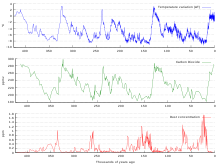
400,000 years of ice core data.
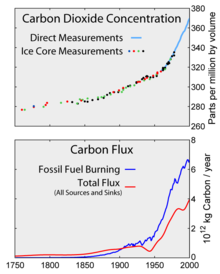
Top: Increasing atmospheric
carbon dioxide levels as measured in the atmosphere and reflected in
ice cores. Bottom: The amount of net carbon increase in the atmosphere, compared to carbon emissions from burning
fossil fuel.
Aside from purely human-produced synthetic halocarbons, most
greenhouse gases have both natural and human-caused sources. During the
pre-industrial
Holocene,
concentrations of existing gases were roughly constant. In the
industrial era, human activities have added greenhouse gases to the
atmosphere, mainly through the burning of fossil fuels and clearing of
forests.
[29][30]
The 2007
Fourth Assessment Report
compiled by the IPCC (AR4) noted that "changes in atmospheric
concentrations of greenhouse gases and aerosols, land cover and solar
radiation alter the energy balance of the climate system", and concluded
that "increases in anthropogenic greenhouse gas concentrations is very
likely to have caused most of the increases in global average
temperatures since the mid-20th century".
[31] In AR4, "most of" is defined as more than 50%.
Ice cores provide evidence for variation in greenhouse gas concentrations over the past 800,000 years. Both
CO2 and
CH4
vary between glacial and interglacial phases, and concentrations of
these gases correlate strongly with temperature. Direct data does not
exist for periods earlier than those represented in the ice core record,
a record which indicates
CO2 mole fractions
staying within a range of between 180 ppm and 280 ppm throughout the
last 800,000 years, until the increase of the last 250 years. However,
various proxies and modeling suggests larger variations in past epochs;
500 million years ago
CO2 levels were likely 10 times higher than now.
[32] Indeed higher
CO2 concentrations are thought to have prevailed throughout most of the
Phanerozoic
eon, with concentrations four to six times current concentrations
during the Mesozoic era, and ten to fifteen times current concentrations
during the early Palaeozoic era until the middle of the
Devonian period, about 400
Ma.
[33][34][35] The spread of land plants is thought to have reduced
CO2 concentrations during the late Devonian, and plant activities as both sources and sinks of
CO2 have since been important in providing stabilising feedbacks.
[36] Earlier still, a 200-million year period of intermittent, widespread glaciation extending close to the equator (
Snowball Earth) appears to have been ended suddenly, about 550 Ma, by a colossal volcanic outgassing which raised the
CO2
concentration of the atmosphere abruptly to 12%, about 350 times modern
levels, causing extreme greenhouse conditions and carbonate deposition
as
limestone at the rate of about 1 mm per day.
[37]
This episode marked the close of the Precambrian eon, and was succeeded
by the generally warmer conditions of the Phanerozoic, during which
multicellular animal and plant life evolved. No volcanic carbon dioxide
emission of comparable scale has occurred since. In the modern era,
emissions to the atmosphere from volcanoes are only about 1% of
emissions from human sources.
[37][38]
Anthropogenic greenhouse gases

Modern global anthropogenic
carbon emissions.
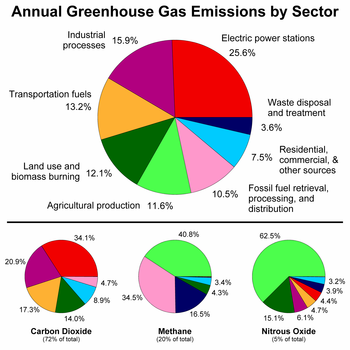
Global anthropogenic greenhouse gas emissions broken down into 8 different sectors for the year 2000.

Per capita anthropogenic greenhouse gas emissions by country for the year 2000 including land-use change.
Since about 1750 human activity has increased the concentration of
carbon dioxide and other greenhouse gases. Measured atmospheric
concentrations of carbon dioxide are currently 100 ppm higher than
pre-industrial levels.
[39] Natural sources of carbon dioxide are more than 20 times greater than sources due to human activity,
[40]
but over periods longer than a few years natural sources are closely
balanced by natural sinks, mainly photosynthesis of carbon compounds by
plants and marine plankton. As a result of this balance, the atmospheric
mole fraction of carbon dioxide remained between 260 and 280 parts per
million for the 10,000 years between the end of the last glacial maximum
and the start of the industrial era.
[41]
It is likely that anthropogenic warming, such as that due to elevated
greenhouse gas levels, has had a discernible influence on many physical
and biological systems. Warming is projected to affect various issues
such as freshwater resources, industry, food and health.
[42]
The main sources of greenhouse gases due to human activity are:
- burning of fossil fuels and deforestation
leading to higher carbon dioxide concentrations in the air. Land use
change (mainly deforestation in the tropics) account for up to one third
of total anthropogenic CO2 emissions.[41]
- livestock enteric fermentation and manure management,[43] paddy rice
farming, land use and wetland changes, pipeline losses, and covered
vented landfill emissions leading to higher methane atmospheric
concentrations. Many of the newer style fully vented septic systems that
enhance and target the fermentation process also are sources of atmospheric methane.
- use of chlorofluorocarbons (CFCs) in refrigeration systems, and use of CFCs and halons in fire suppression systems and manufacturing processes.
- agricultural activities, including the use of fertilizers, that lead to higher nitrous oxide (N2O) concentrations.
The seven sources of
CO2 from fossil fuel combustion are (with percentage contributions for 2000–2004):
[44]
Seven main fossil fuel
combustion sources |
Contribution
(%) |
| Liquid fuels (e.g., gasoline, fuel oil) |
36 % |
| Solid fuels (e.g., coal) |
35 % |
| Gaseous fuels (e.g., natural gas) |
20 % |
| Cement production |
3 % |
| Flaring gas industrially and at wells |
< 1 % |
| Non-fuel hydrocarbons |
< 1 % |
"International bunker fuels" of transport
not included in national inventories |
4 % |
The
US Environmental Protection Agency
(EPA) ranks the major greenhouse gas contributing end-user sectors in
the following order: industrial, transportation, residential, commercial
and agricultural.
[45]
Major sources of an individual's greenhouse gas include home heating
and cooling, electricity consumption, and transportation. Corresponding
conservation measures are improving home
building insulation, installing
geothermal heat pumps and
compact fluorescent lamps, and choosing
energy-efficient vehicles.
Carbon dioxide,
methane,
nitrous oxide and three groups of
fluorinated gases (
sulfur hexafluoride,
HFCs, and
PFCs) are the major greenhouse gases and the subject of the
Kyoto Protocol, which came into force in 2005.
[46]
Although
CFCs are greenhouse gases, they are regulated by the
Montreal Protocol, which was motivated by CFCs' contribution to
ozone depletion
rather than by their contribution to global warming. Note that ozone
depletion has only a minor role in greenhouse warming though the two
processes often are confused in the media.
On December 7, 2009, the
US Environmental Protection Agency
released its final findings on greenhouse gases, declaring that
"greenhouse gases (GHGs) threaten the public health and welfare of the
American people". The finding applied to the same "six key well-mixed
greenhouse gases" named in the
Kyoto Protocol:
carbon dioxide,
methane,
nitrous oxide,
hydrofluorocarbons,
perfluorocarbons, and
sulfur hexafluoride.
[47][48]
Role of water vapor

Increasing water vapor in the stratosphere at Boulder, Colorado.
Water vapor
accounts for the largest percentage of the greenhouse effect, between
36% and 66% for clear sky conditions and between 66% and 85% when
including clouds.
[12]
Water vapor concentrations fluctuate regionally, but human activity
does not significantly affect water vapor concentrations except at local
scales, such as near irrigated fields. The atmospheric concentration of
vapor is highly variable, from less than 0.01% in extremely cold
regions up to 20% in warm, humid regions.
[49]
The average residence time of a water molecule in the atmosphere is
only about nine days, compared to years or centuries for other
greenhouse gases such as CH
4 and CO
2. Thus, water vapor responds to and amplifies effects of the other greenhouse gases. The
Clausius-Clapeyron relation
establishes that air can hold more water vapor per unit volume when it
warms. This and other basic principles indicate that warming associated
with increased concentrations of the other greenhouse gases also will
increase the concentration of water vapor. Because water vapor is a
greenhouse gas, this results in further warming and so is a "
positive feedback"
that amplifies the original warming. Eventually other earth processes
offset these positive feedbacks, stabilizing the global temperature at a
new equilibrium and preventing the loss of Earth's water through a
Venus-like
runaway greenhouse effect.
[50]
Atmospheric concentration
Measurements from Antarctic ice cores show that before industrial emissions started atmospheric CO
2 mole fractions were about 280
parts per million (ppm), and stayed between 260 and 280 during the preceding ten thousand years.
[51]
Carbon dioxide mole fractions in the atmosphere have gone up by
approximately 35 percent since the 1900s, rising from 280 parts per
million by volume to 387 parts per million in 2009. One study using
evidence from
stomata
of fossilized leaves suggests greater variability, with carbon dioxide
mole fractions above 300 ppm during the period seven to ten thousand
years ago,
[52] though others have argued that these findings more likely reflect calibration or contamination problems rather than actual CO
2 variability.
[53][54]
Because of the way air is trapped in ice (pores in the ice close off
slowly to form bubbles deep within the firn) and the time period
represented in each ice sample analyzed, these figures represent
averages of atmospheric concentrations of up to a few centuries rather
than annual or decadal levels.
Since the beginning of the Industrial Revolution, the concentrations
of most of the greenhouse gases have increased. For example, the mole
fraction of carbon dioxide has increased from 280 ppm by about 36% to
380 ppm, or 100 ppm over modern pre-industrial levels. The first 50 ppm
increase took place in about 200 years, from the start of the Industrial
Revolution to around 1973; however the next 50 ppm increase took place
in about 33 years, from 1973 to 2006.
[55]
Recent data also shows that the concentration is increasing at a
higher rate. In the 1960s, the average annual increase was only 37% of
what it was in 2000 through 2007.
[56]
Today, the stock of carbon in the atmosphere increases by more than 3
million tonnes per annum (0.04%) compared with the existing stock.
[clarification needed]
This increase is the result of human activities by burning fossil
fuels, deforestation and forest degradation in tropical and boreal
regions.
[57]
The other greenhouse gases produced from human activity show similar
increases in both amount and rate of increase. Many observations are
available online in a variety of
Atmospheric Chemistry Observational Databases.
Relevant to radiative forcing
| Gas |
Current (1998)
Amount by volume |
Increase
(absolute, ppm)
over pre-industrial (1750) |
Increase
(relative, %)
over pre-industrial (1750) |
Radiative
forcing
(W/m2) |
| Carbon dioxide |
365 ppm
(383 ppm, 2007.01) |
87 ppm
(105 ppm, 2007.01) |
31 %
(38 %, 2007.01) |
1.46
(~1.53, 2007.01) |
| Methane |
1745 ppb |
1045 ppb |
150 % |
0.48 |
| Nitrous oxide |
314 ppb |
44 ppb |
16 % |
0.15 |
Relevant to both radiative forcing and ozone depletion; all of the following have no natural sources and hence zero amounts pre-industrial
| Gas |
Current (1998)
Amount by volume |
Radiative forcing
(W/m2) |
| CFC-11 |
268 ppt |
0.07 |
| CFC-12 |
533 ppt |
0.17 |
| CFC-113 |
84 ppt |
0.03 |
| Carbon tetrachloride |
102 ppt |
0.01 |
| HCFC-22 |
69 ppt |
0.03 |
(Source:
IPCC radiative forcing report 1994 updated (to 1998) by IPCC TAR table 6.1
[58][59] ).
Greenhouse gas emissions ("sources")

Recent year-to-year increase of atmospheric CO
2.
Between the period 1970 to 2004, GHG emissions (measured in
CO2-equivalent)
[60] increased at an average rate of 1.6% per year, with CO
2 emissions from the use of fossil fuels growing at a rate of 1.9% per year.
[61][62] Total anthropogenic emissions at the end of 2009 were estimated at 49.5
gigatonnes CO2-equivalent.
[63] These emissions include
CO2 from fossil fuel use and from land use, as well as emissions of methane, nitrous oxide and other GHGs covered by the
Kyoto Protocol.
At present, the two primary sources of CO
2 emissions are from burning
coal used for electricity generation and
petroleum used for motor transport.
[citation needed]
Regional and national attribution of emissions
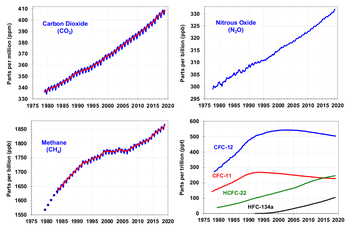
Major greenhouse gas trends.
There are several different ways of measuring GHG emissions (see
World Bank (2010, p. 362) for a table of national emissions data).
[64]
Some variables that have been reported
[65] include:
- Definition of measurement boundaries. Emissions can be attributed
geographically, to the area where they were emitted (the territory
principle) or by the activity principle to the territory that caused the
emissions to be produced. These two principles would result in
different totals when measuring for example the importation of
electricity from one country to another or the emissions at an
international airport.
- The time horizon of different GHGs. Contribution of a given GHG is reported as a CO2
equivalent; the calculation to determine this takes into account how
long that gas remains in the atmosphere. This is not always known
accurately and calculations must be regularly updated to take into
account new information.
- What sectors are included in the calculation (e.g. energy
industries, industrial processes, agriculture etc.). There is often a
conflict between transparency and availability of data.
- The measurement protocol itself. This may be via direct measurement
or estimation; the four main methods are the emission factor-based
method, the mass balance method, the predictive emissions monitoring
system and the continuing emissions monitoring systems. The methods
differ in accuracy, but also in cost and usability.
The different measures are sometimes used by different countries in
asserting various policy/ethical positions to do with climate change
(Banuri
et al., 1996, p. 94).
[66]
This use of different measures leads to a lack of comparability, which
is problematic when monitoring progress towards targets. There are
arguments for the adoption of a common measurement tool, or at least the
development of communication between different tools.
[65]
Emissions may be measured over long time periods. This measurement
type is called historical or cumulative emissions. Cumulative emissions
give some indication of who is responsible for the build-up in the
atmospheric concentration of GHGs (IEA, 2007, p. 199).
[67]
The national accounts balance would be positively related to carbon
emissions. The national accounts balance shows the difference between
exports and imports. For many richer nations, such as the United States,
the accounts balance is negative because more goods are imported than
they are exported. This is mostly due to the fact that it is cheaper to
produce goods outside of developed countries, leading the economies of
developed countries to become increasingly dependent on services and not
goods. We believed that a positive accounts balance would means that
more production was occurring in a country, so more factories working
would increase carbon emission levels.(Holtz-Eakin, 1995, pp.;85;101).
[68]
Emissions may also be measured across shorter time periods. Emissions
changes may, for example, be measured against a base year of 1990. 1990
was used in the
United Nations Framework Convention on Climate Change (UNFCCC) as the base year for emissions, and is also used in the
Kyoto Protocol (some gases are also measured from the year 1995) (Grubb, 2003, pp. 146, 149).
[69] A country's emissions may also be reported as a proportion of global emissions for a particular year.
Another measurement is of per capita emissions. This divides a
country's total annual emissions by its mid-year population (World Bank,
2010, p. 370). Per capita emissions may be based on historical or
annual emissions (Banuri
et al., 1996, pp. 106–107).
Greenhouse gas intensity and land-use change
Greenhouse gas intensity in the year 2000, including land-use change.
Cumulative energy-related
CO2 emissions between the years 1850-2005 grouped into low-income, middle-income, high-income, the
EU-15, and the
OECD countries.
Cumulative energy-related CO2 emissions between the years 1850-2005 for individual countries.
Map of cumulative per capita anthropogenic atmospheric CO2 emissions by country. Cumulative emissions include land use change, and are measured between the years 1950 and 2000.
Regional trends in annual CO2 emissions from fuel combustion between 1971 and 2009.
Regional trends in annual per capita CO2 emissions from fuel combustion between 1971 and 2009.
The first figure shown opposite is based on data from the
World Resources Institute, and shows a measurement of GHG emissions for the year 2000 according to
greenhouse gas intensity and
land-use change. Herzog
et al. (2006, p. 3) defined greenhouse gas intensity as GHG emissions divided by economic output.
[70] GHG intensities are subject to uncertainty over whether they are calculated using
market exchange rates (MER) or
purchasing power parity (PPP) (Banuri
et al., 1996, p. 96).
[66]
Calculations based on MER suggest large differences in intensities
between developed and developing countries, whereas calculations based
on PPP show smaller differences.
Land-use change, e.g., the clearing of forests for agricultural use,
can affect the concentration of GHGs in the atmosphere by altering how
much carbon flows out of the atmosphere into
carbon sinks.
[71]
Accounting for land-use change can be understood as an attempt to
measure “net” emissions, i.e., gross emissions from all GHG sources
minus the removal of emissions from the atmosphere by carbon sinks
(Banuri
et al., 1996, pp. 92–93).
There are substantial uncertainties in the measurement of net carbon emissions.
[72] Additionally, there is controversy over how carbon sinks should be allocated between different regions and over time (Banuri
et al.,
1996, p. 93). For instance, concentrating on more recent changes in
carbon sinks is likely to favour those regions that have deforested
earlier, e.g., Europe.
Cumulative and historical emissions
Cumulative anthropogenic (i.e., human-emitted) emissions of
CO2 from fossil fuel use are a major cause of
global warming,
[73] and give some indication of which countries have contributed most to human-induced climate change.
[74]:15
Top-5 historic CO2 contributors by region over the years 1800 to 1988 (in %)
| Region |
Industrial
CO2 |
Total
CO2 |
| OECD North America |
33.2 |
29.7 |
| OECD Europe |
26.1 |
16.6 |
| Former USSR |
14.1 |
12.5 |
| China |
5.5 |
6.0 |
| Eastern Europe |
5.5 |
4.8 |
The table above to the left is based on Banuri
et al. (1996, p. 94).
[66] Overall, developed countries accounted for 83.8% of industrial CO
2 emissions over this time period, and 67.8% of total CO
2 emissions. Developing countries accounted for industrial CO
2 emissions of 16.2% over this time period, and 32.2% of total CO
2 emissions. The estimate of total CO
2 emissions includes
biotic carbon emissions, mainly from deforestation. Banuri
et al.
(1996, p. 94) calculated per capita cumulative emissions based on
then-current population. The ratio in per capita emissions between
industrialized countries and developing countries was estimated to be
more than 10 to 1.
Including biotic emissions brings about the same controversy
mentioned earlier regarding carbon sinks and land-use change (Banuri
et al.,
1996, pp. 93–94). The actual calculation of net emissions is very
complex, and is affected by how carbon sinks are allocated between
regions and the dynamics of the climate system.
Non-
OECD countries accounted for 42% of cumulative energy-related
CO2 emissions between 1890-2007.
[75]:179-180
Over this time period, the US accounted for 28% of emissions; the EU,
23%; Russia, 11%; China, 9%; other OECD countries, 5%; Japan, 4%; India,
3%; and the rest of the world, 18%.
[75]:179-180
Changes since a particular base year
Between 1970-2004, global growth in annual
CO2 emissions was driven by North America, Asia, and the Middle East.
[76] The sharp acceleration in CO
2
emissions since 2000 to more than a 3% increase per year (more than
2 ppm per year) from 1.1% per year during the 1990s is attributable to
the lapse of formerly declining trends in
carbon intensity
of both developing and developed nations. China was responsible for
most of global growth in emissions during this period. Localised
plummeting emissions associated with the collapse of the
Soviet Union have been followed by slow emissions growth in this region due to more
efficient energy use, made necessary by the increasing proportion of it that is exported.
[44] In comparison, methane has not increased appreciably, and N
2O by 0.25% y
−1.
Using different base years for measuring emissions has an effect on estimates of national contributions to global warming.
[74]:17-18[77]
This can be calculated by dividing a country's highest contribution to
global warming starting from a particular base year, by that country's
minimum contribution to global warming starting from a particular base
year. Choosing between different base years of 1750, 1900, 1950, and
1990 has a significant effect for most countries.
[74]:17-18 Within the
G8 group of countries, it is most significant for the UK, France and Germany. These countries have a long history of
CO2 emissions (see the section on
Cumulative and historical emissions).
Annual emissions
Annual per capita emissions in the industrialized countries are
typically as much as ten times the average in developing countries.
[69]:144 Due to China's fast economic development, its annual per capita emissions are quickly approaching the levels of those in the
Annex I group of the Kyoto Protocol (i.e., the developed countries excluding the USA).
[78] Other countries with fast growing emissions are
South Korea, Iran, and
Australia. On the other hand, annual per capita emissions of the EU-15 and the USA are gradually decreasing over time.
[78] Emissions in
Russia and the
Ukraine have decreased fastest since 1990 due to economic restructuring in these countries.
[79]
Energy statistics for fast growing economies are less accurate than
those for the industrialized countries. For China's annual emissions in
2008, the
Netherlands Environmental Assessment Agency estimated an uncertainty range of about 10%.
[78]
Top emitters
Bar graph of annual per capita CO2 emissions from fuel combustion for 140 countries in 2009.
Bar graph of cumulative energy-related per capita CO2 emissions between 1850-2008 for 185 countries.
Annual
In 2009, the annual top ten emitting countries accounted for about two-thirds of the world's annual energy-related
CO2 emissions.
[80]
Cumulative
Embedded emissions
One way of attributing greenhouse gas (GHG) emissions is to measure the
embedded emissions
(also referred to as "embodied emissions") of goods that are being
consumed. Emissions are usually measured according to production, rather
than consumption.
[83] For example, in the main international
treaty on climate change (the
UNFCCC), countries report on emissions produced within their borders, e.g., the emissions produced from burning fossil fuels.
[75]:179[84]:1
Under a production-based accounting of emissions, embedded emissions on
imported goods are attributed to the exporting, rather than the
importing, country. Under a consumption-based accounting of emissions,
embedded emissions on imported goods are attributed to the importing
country, rather than the exporting, country.
Davis and Caldeira (2010)
[84]:4 found that a substantial proportion of CO
2
emissions are traded internationally. The net effect of trade was to
export emissions from China and other emerging markets to consumers in
the US, Japan, and Western Europe. Based on annual emissions data from
the year 2004, and on a per-capita consumption basis, the top-5 emitting
countries were found to be (in tCO
2 per person, per year): Luxembourg (34.7), the US (22.0), Singapore (20.2), Australia (16.7), and Canada (16.6).
[84]:5
Effect of policy
Rogner
et al. (2007) assessed the effectiveness of policies to reduce emissions (
mitigation of climate change).
[61]
They concluded that mitigation policies undertaken by UNFCCC Parties
were inadequate to reverse the trend of increasing GHG emissions. The
impacts of population growth, economic development, technological
investment, and consumption had overwhelmed improvements in energy
intensities and efforts to decarbonize (energy intensity is a country's
total primary energy supply (TPES) per unit of
GDP (Rogner
et al., 2007).
[85] TPES is a measure of commercial energy consumption (World Bank, 2010, p. 371)).
[64]
Projections
Based on then-current energy policies, Rogner et al. (2007) projected that energy-related CO
2 emissions in 2030 would be 40-110% higher than in 2000.
[61]
Two-thirds of this increase was projected to come from non-Annex I
countries. Per capita emissions in Annex I countries were still
projected to remain substantially higher than per capita emissions in
non-Annex I countries. Projections consistently showed a 25-90% increase
in the Kyoto gases (carbon dioxide, methane, nitrous oxide, sulphur
hexafluoride) compared to 2000.
IEA (2007, p. 199) estimated future cumulative energy-related CO
2 emissions for several countries.
[67] Their reference
scenario projected cumulative energy-related CO
2
emissions between the years 1900 and 2030. In this scenario, China’s
share of cumulative emissions rises to 16%, approaching that of the
United States (25%) and the European Union (18%). India’s cumulative
emissions (4%) approach those of Japan (4%).
Relative CO2 emission from various fuels
One liter of gasoline, when used as a fuel, produces
2.32 kg (1.3 cubic meters) of carbon dioxide, a greenhouse gas. One US gallon produces 19.4 lb (172.65 cubic feet)
[86][87][88]
 As
the world gears up for the United Nations Conference on Sustainable
Development (Rio+20), World Environment Day is an opportunity to
highlight the need for a paradigm shift towards a more sustainable
world. This year’s theme, “Green Economy: Does it include you?”, underscores the need for everyone to play their part in keeping humankind's ecological footprint within planetary boundaries.
As
the world gears up for the United Nations Conference on Sustainable
Development (Rio+20), World Environment Day is an opportunity to
highlight the need for a paradigm shift towards a more sustainable
world. This year’s theme, “Green Economy: Does it include you?”, underscores the need for everyone to play their part in keeping humankind's ecological footprint within planetary boundaries.


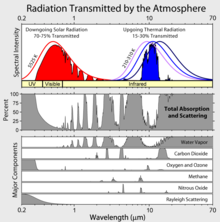

 of an atmospheric
of an atmospheric  (in kg) of X in the box to its removal rate, which is the sum of the flow of X out of the box (
(in kg) of X in the box to its removal rate, which is the sum of the flow of X out of the box ( ), chemical loss of X (
), chemical loss of X ( ), and
), and  ) (all in kg/sec):
) (all in kg/sec):  .
.














